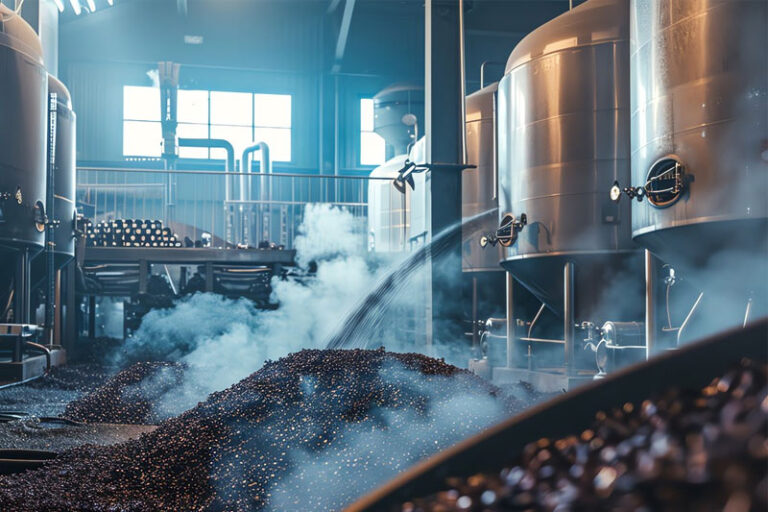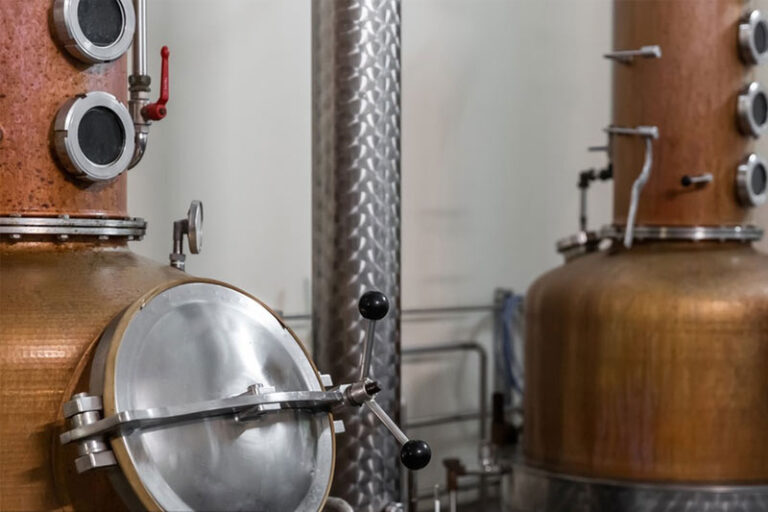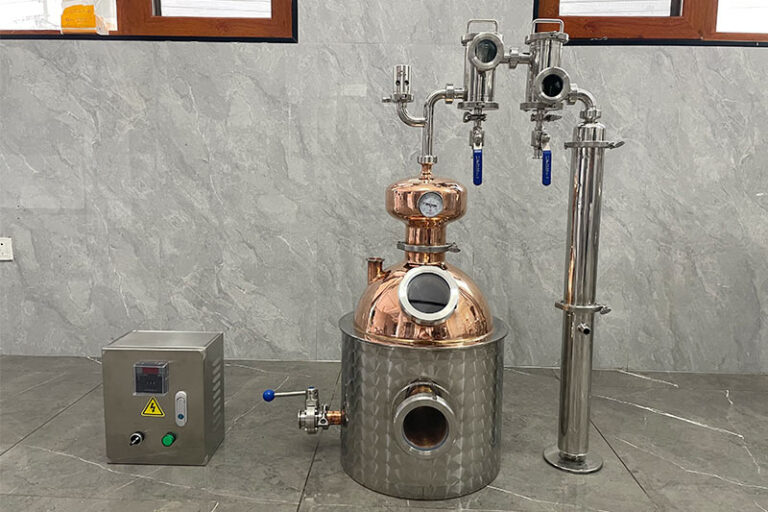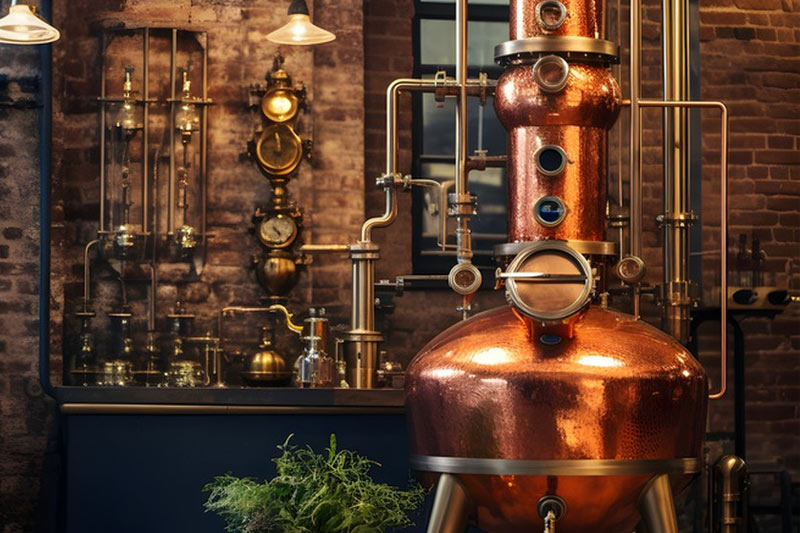Distillation equipment plays an important role in many industries and beverage industries, and the continuous innovation of design and function has promoted the development of related industries. Choosing the right distillation equipment can effectively improve production efficiency, reduce energy consumption, and ensure the quality of the final product. With the diversification of demand and the advancement of technology, distillation equipment is increasingly used in fields such as the brewing industry and environmental protection.
What is distillation equipment?
Distillation equipment is a device or system used to separate a mixture into different components by heating and cooling. The distillation process uses the difference in boiling points of different components in a mixture to separate or purify substances. Distillation equipment is widely used in industries such as chemical, petroleum, pharmaceutical, food, and beverage.

Different types of distillation equipment
- Simple distillation equipment: Simple distillation equipment is the most basic distillation device and is suitable for separating liquids with large boiling point differences. The main components include a heater, distillation flask, condenser, and receiver. Simple distillation works by heating a liquid to evaporate it, and the vapor is cooled through a condenser into a liquid and collected in a receiver. This equipment is suitable for separating substances with significant boiling point differences.
- Fracting tower: A fractionating tower is a device used to separate liquids with close boiling points. It consists of a tall tower, heating device, condenser, splitter, and multi-layer trays or packing. The fractionation tower gradually separates the components in the mixture through repeated evaporation and condensation processes. Each layer of trays or packings provides an evaporation-condensation cycle, which gradually enhances the separation effect.
- Steam distillation equipment: Steam distillation equipment uses steam as a heat source to evaporate volatile components in the mixture. Steam distillation is mainly suitable for substances with high boiling points or substances that are difficult to distill directly. By injecting steam into a liquid mixture, the steam carries away volatile substances to form a vapor, which condenses to produce a pure liquid.
- Vacuum distillation equipment: Based on conventional distillation, vacuum distillation equipment reduces the boiling point of the liquid by reducing the pressure, thereby achieving separation. This method is suitable for separating substances with high boiling points or heat-sensitive substances. In a vacuum environment, liquids do not need to be heated to high temperatures to evaporate, reducing the risk of adverse reactions.
- Molecular distillation equipment: Molecular distillation equipment is an efficient distillation technology, usually used for the separation of low boiling point substances. It achieves finer separation by reducing collisions between molecules under high vacuum conditions. This distillation equipment can perform distillation at very low temperatures and is suitable for processing heat-sensitive substances.
How to choose the right distillation and brewing equipment?
Determine the type and scale of production of distilled spirits
- Small wineries or experimental production: For small-scale wineries or experimental production, you may need small-capacity distillation equipment. These equipment are usually more flexible and suitable for small-batch production, which can help winemakers experiment with different recipes and processes. Common small-scale distillation equipment includes vertical distillation pots or portable distillers.
- Medium-sized wineries: For medium-sized wineries, the selected equipment needs to have sufficient capacity and high production efficiency. For example, you may need a medium-sized distillation tower or double distillation system to improve distillation efficiency while ensuring alcohol purity.
- Large wineries: For large-scale distillation wineries, more efficient large distillation towers or boilers, as well as distillation systems that can operate continuously, are usually required. Continuous distillation systems can extract alcohol more efficiently and keep production stable.

Choose the right distillation pot and distillation tower
- Copper distillation pot: Copper has excellent thermal conductivity and can react chemically with the liquor to help remove undesirable sulfides, so many high-end distilled spirits (such as brandy and whiskey) use copper distillation pots. Copper pots can help the wine to distill more smoothly and contribute to the taste and flavor of the wine.
- Stainless steel distillation pots: Stainless steel is more durable and easy to clean, suitable for large-scale wineries. Although it is not as likely to affect the flavor as copper pots, its corrosion resistance, easy cleaning, and maintenance make it the first choice for some modern wineries.
- Continuous distillation tower: A continuous distillation tower is suitable for large-scale and efficient distilled wine production. It can extract alcohol in an uninterrupted process through continuous heating and condensation, and can more efficiently separate alcohol and impurities to provide purer alcohol.
- Batch distillation: Batch distillation is usually suitable for high-quality handmade wines or small-batch production. It can accurately control the conditions of each distillation, such as temperature, steam flow, etc., which helps to improve the unique flavor of the wine.
Consider distillation efficiency and output
Efficient distillation equipment can extract alcohol from fermentation broth faster and improve the purity of alcohol. For example, using a multi-stage distillation tower or a double distillation system (two distillations) can improve the purity and quality of alcohol.
Batch production is suitable for processes that require fine control, such as small batches of high-end wines, while continuous production is suitable for wineries that require large-scale production. Continuous distillation systems can improve production efficiency and save energy and time.
Consider the energy efficiency and environmental protection requirements of the equipment
With increasingly stringent environmental regulations, it is particularly important to choose energy-efficient and environmentally friendly distillation equipment. Efficient distillation equipment can save energy and reduce greenhouse gas emissions. Ensuring that the equipment meets energy efficiency standards and environmental requirements can not only reduce operating costs but also help wineries comply with government regulations.
Budget and return on investment
The selection of distillation equipment depends not only on its function and performance but also on budget. High-end distillation equipment may require a higher initial investment, but through its efficient production capacity, energy saving, and low maintenance costs, it can get a better return on investment in the long run. It is recommended to choose the right equipment according to the production scale and goals of the winery and make a comprehensive trade-off within the budget.

How to maintain distilling equipment?
Regular cleaning and descaling
After long-term use, distilling equipment is prone to dregs, dirt, and residues, especially in the distillation pot and condenser. Therefore, regular cleaning is the first step to ensure the efficient operation of the equipment. Copper distillation pots need special attention to avoid oxidation, and can be cleaned with professional cleaners, while stainless steel equipment can use acid cleaners to remove scale and mineral deposits. Cleaning the condensation system is also crucial, as deposits will affect the efficiency of heat exchange.
Check seals and pipes
During the distillation process, sealing is very critical. All seals and pipes of the equipment should be checked regularly to ensure that there are no leaks or damage. Steam leaks not only waste energy but may also affect the efficiency of the distillation process and the purity of the wine. Replace aged or damaged seals and pipes to ensure the sealing and safety of the equipment.
Maintain steam boilers and heat sources.
The steam boiler is one of the core components in the distillation process and needs to be checked and cleaned regularly. Check the steam output pressure of the boiler to ensure that it is operating properly. Scale and mineral deposits may accumulate in the boiler, so it needs to be cleaned regularly with a descaling agent to maintain its thermal efficiency and extend the life of the equipment.
Check the condenser and cooling system.
The efficiency of the condenser is directly related to the efficiency of alcohol extraction. Regularly check the heat dissipation pipes of the condenser, clean any possible blockages, and ensure that the cooling water flows smoothly. Equipment using water cooling needs to clean the water pipes regularly to prevent scale accumulation from affecting the condensation effect. Ensure that the water source of the cooling system is clean to improve the cooling efficiency of the equipment.
Check the temperature control and pressure control system.
Modern distillation equipment is usually equipped with an automated temperature control and pressure control system. Regularly check the accuracy and responsiveness of these systems to ensure that the temperature and pressure are within the ideal range. The sensors of the temperature control system should be calibrated regularly to prevent excessively high or low temperatures from affecting the distillation process and, in turn, the quality of the wine.
Check the electrical and automation systems
For distillation equipment with a high degree of automation, the maintenance of the electrical and automation control systems is particularly important. Regularly check the control panel, sensors, wires, and electrical connections to ensure that the equipment can operate stably. The software system should be updated regularly to adapt to technological advances and improve operational efficiency.
Keep the equipment dry and corrosion-resistant
During the cleaning and maintenance process, special attention should be paid to the dryness of the equipment to avoid long-term moisture inside the equipment to prevent corrosion and rust. Copper and stainless steel equipment are particularly susceptible to moisture, so keep the equipment dry during storage and check regularly for possible signs of corrosion.
Regularly check and maintain parts
Regularly check the parts of the distillation equipment, including the lid, valves, pipe connections, etc., to ensure that they are not worn or aged. Any damaged parts should be replaced as soon as possible to avoid affecting the distillation process and the normal operation of the equipment.

